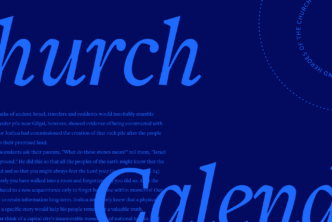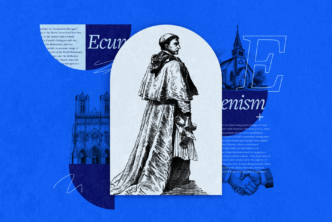It’s C.S. Lewis week here at Faithlife! We’re celebrating the scholar’s life and writings and the 30-volume C.S. Lewis Collection.
This is a post from Faithlife staff member Ben Amundgaard critiquing three scholarly works included in this collection.
Many people know C.S. Lewis mainly as a Christian apologist and the author of The Chronicles of Narnia. While it is true that Lewis wrote many successful works of Christian theology and fiction, he was first and foremost a scholar. In that role, he made significant contributions to the academy as a literary critic and medievalist. Some of the most significant include The Allegory of Love, Studies in Words, and The Discarded Image.
The Allegory of Love: A Study in Medieval Tradition
Published in 1936, The Allegory of Love is an exploration of the way writers from the High Medieval and Renaissance periods treat the subject of love, the method of allegory, and the relationship between the two. The type of love Lewis looks at is what might be called courtly or chivalrous love—a particular understanding of love that flowered in the High Middle Ages.
The sentiment, of course, is love, but love of a highly specialized sort . . . the lover is always abject. Obedience to his lady’s lightest wish, however whimsical, and silent acquiescence in her rebukes, however unjust, are the only virtues he dares claim.
This type of love is often caricatured in modern retellings of romantic poetry and fairy tales.
Lewis examines medieval and Renaissance authors’ use of courtly love within the context of allegory. Allegory in the Middle Ages drew on themes and ideas from both the Bible and classical texts, creating a synthesis that was a development on, rather than a rejection of, the ideals of the classical world. Lewis argues that the medieval understanding of allegory and love are so foreign to the modern reader that they are almost repugnant:
The allegorical love poetry of the Middle Ages is apt to repel the modern reader both by its form and by its matter. The form . . . can hardly be expected to appeal to an age which holds that “art means what it says” or even that art is meaningless—for it is essential to this form that the literal narrative and the significacio should be separable.”
Nevertheless, he argues that we will understand our current situation and where we are headed “if we can succeed, by an effort of the historical imagination, in reconstructing that long-lost state of mind for which the allegorical love poem was a natural mode of expression.” This, he argues, will only happen if we understand this literature within its historical context.
Lewis begins his study by looking at the development of courtly love and allegory leading up to the works he is to examine. He then looks at specific examples of allegorical love in continental works like The Romance of the Rose and in authors such as Bernard Silvestris. The bulk of his work, however, focuses more specifically on allegory and love in English works like The Faerie Queen and in authors such as Chaucer, Spenser, and Gower.
This volume shows Lewis’ deep understanding of, and love for, the understanding of love and allegory in the Middle Ages. It is an important work for anyone studying medieval literature who wants to better understand these concepts. It will also be a pleasurable read for anyone who shares Lewis’ appreciation for this particular genre.
Studies in Words
Studies in Words, published in 1960, is an in-depth look at the semantic history of language and words. Lewis believed that students of classical and medieval literature were in danger of misinterpreting the author’s intent because they were unaware of the changes a particular word has gone through since the work was written:
If we read an old poem with insufficient regard for change in the overtones, and even the dictionary meanings, of words since its date—if, in fact, we are content with whatever effect the words accidentally produce in our modern minds—then, of course, we do not read the poem the old writer intended.”
Awareness of how a word’s meaning changes over time can help one understand an author’s original intent. Tracing the history of a word is key to this awareness.
Lewis examines the semantic history of a number of words (and one phrase) from English literature to illustrate the danger of misreading and to demonstrate the method for tracing the change in meaning over time. Beginning with the Latin and Greek roots, Lewis examines nature, sad, wit, free, sense, simple, conscience and conscious, world, life, and “I dare say.” Each chapter examines a particular word or phrase, looking not only at the word itself but also at words that are related and whose meanings, over time, have influenced the meaning of the word in question.
A good example of the change Lewis is tracing comes in a rather impassioned section in the chapter on the word “free”:
Unless followed by the word “education,” liberal has now lost this meaning [seeking knowledge or doing something for its own sake—i.e. “freely” with no exterior motive]. For that loss, so damaging to the whole of our cultural outlook, we must thank those who made it the name, first of a political, and then a religious, party.”
Time and misuse have so strained the relationship between the definition of liberal and free that many don’t even see the connection anymore. This lack of awareness might cause one to read onto an earlier reference to the word “liberal” a political connotation rather than its connection to free learning.
Lewis demonstrates the same patterns and illustrates the same dangers for the other words he has chosen. His clear arguments and thorough analysis drive home the importance of knowing the semantic history. This book is essential for anyone studying literature written outside of their own place and time.
The Discarded Image: An Introduction to Medieval and Renaissance Literature
Published posthumously in 1964, The Discarded Image was Lewis’ last technically academic work. A work primarily of literary criticism, it gathers the wisdom from Lewis’ years as a linguist, a medievalist, and literary critic. The volume is geared toward helping people better read medieval literature by understanding the medieval worldview.
Lewis’ understanding of medieval cosmology was undergirded by his study of allegory in the Middle Ages (such as he examined in The Allegory of Love). Lewis built on the idea of a “Medieval Synthesis,” defined as “the whole organization of their theology, science, and history into a single, complex, harmonious mental model of the universe.” This synthesis was created, in part, by the use of allegory to reconcile biblical ideas with concepts from classical literature.
The name of the book comes from Lewis’ view that the medieval understanding (or image) of the world had been discarded following the scientific revolution. He believed that the discarding of this medieval image made it difficult for readers to enter, and correctly understand, literature from the Middle Ages.
Lewis was honest about his appreciation for the medieval understanding of the universe.
I have made no serious effort to hide the fact that the old Model delights me as I believe it delighted our ancestors. Few constructions of the imagination seem to me to have combined splendor, sobriety, and coherence in the same degree.”
He is careful to point out, though, that he does not believe to be true in the sense that we think of truth, nor is he suggesting a return to the model. Yet, he suggests that this model of the universe, as all models, contains some truth.
No model is a catalog of ultimate realities, and none is a mere fantasy. Each is a serious attempt to get in all the phenomena known at a given period, and each succeeds in getting in a great many.”
In other words, there is wisdom to be gained by studying the medieval worldview and the literature it produced. Though the medieval image of the universe has been replaced by one founded on modern science, we stand to lose a great deal if we discard it.
This volume is not only a rich exploration of an important topic, it is a delight to read. It is essential for anyone studying the Middle Ages or anyone who shares Lewis’ affection for the period. Whether you are a professional scholar or armchair academic, you’ll benefit from this important work.
***
The Allegory of Love, Studies in Words, and The Discarded Image are part of the C.S. Lewis Collection.
For more posts about Lewis, see below:
C. S. Lewis Quotes on Love, Life, God and More
Look. Listen. Receive. C.S. Lewis on Reading
C.S. Lewis’ Ingenious Apologetic of Longing
Men Without Chests: Lewis, Relativism, and the Soul of Christianity





